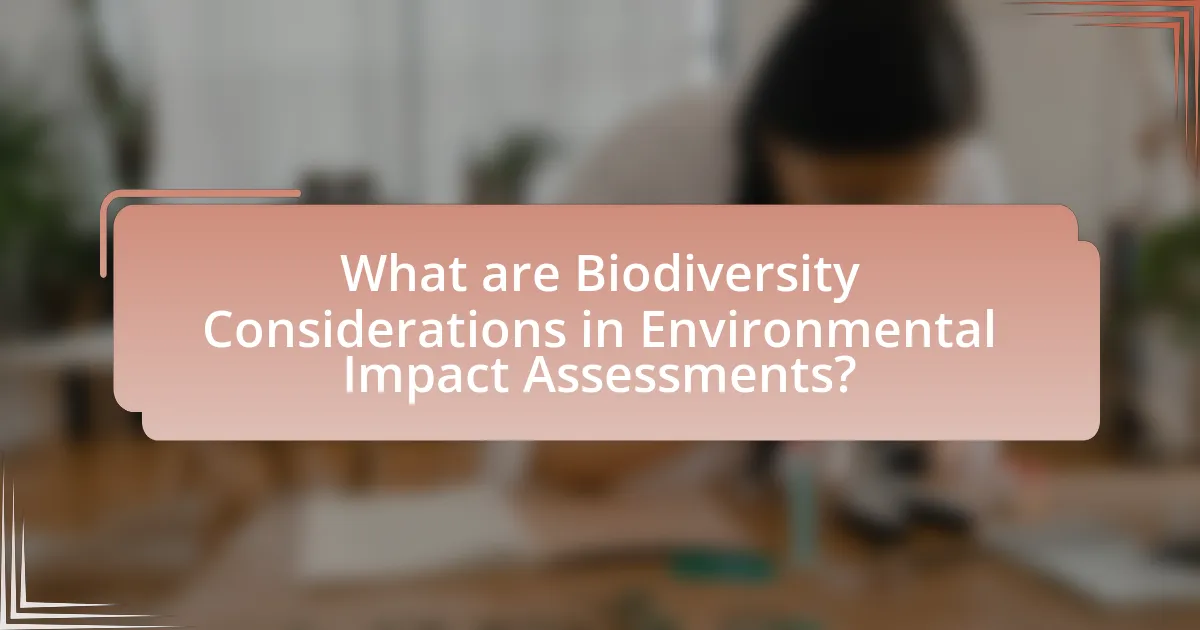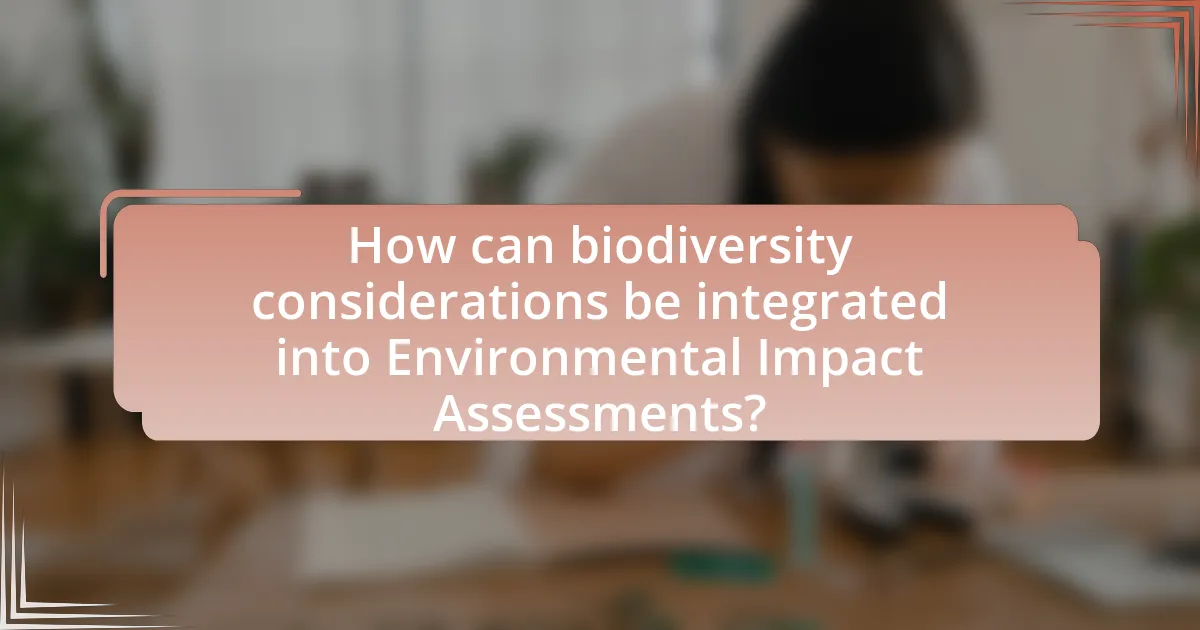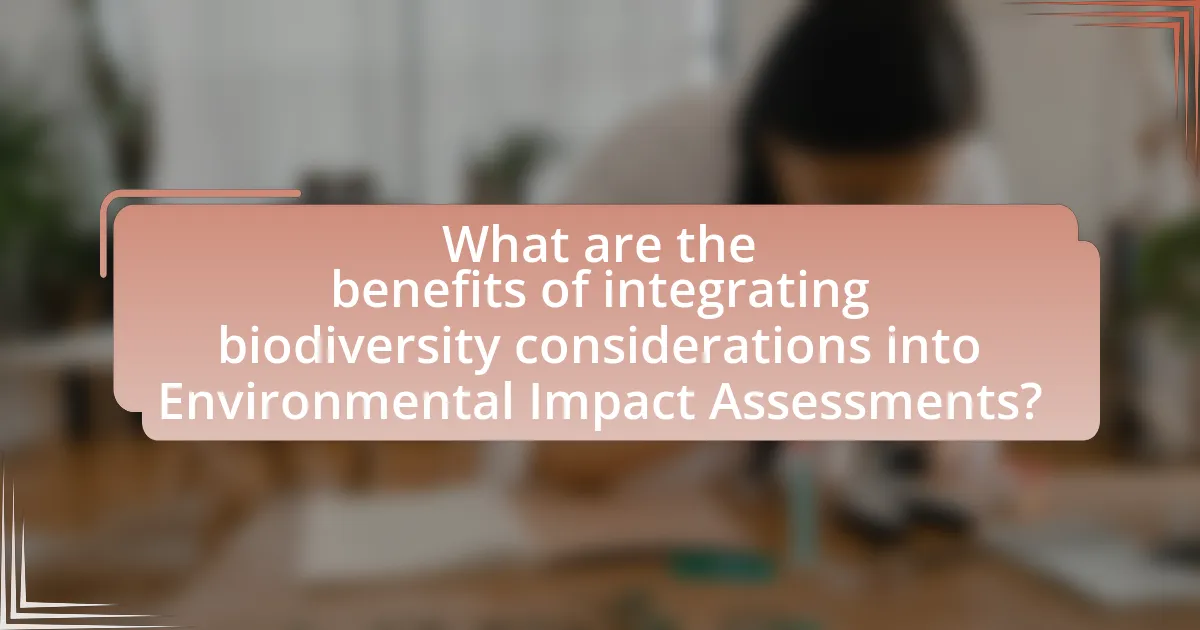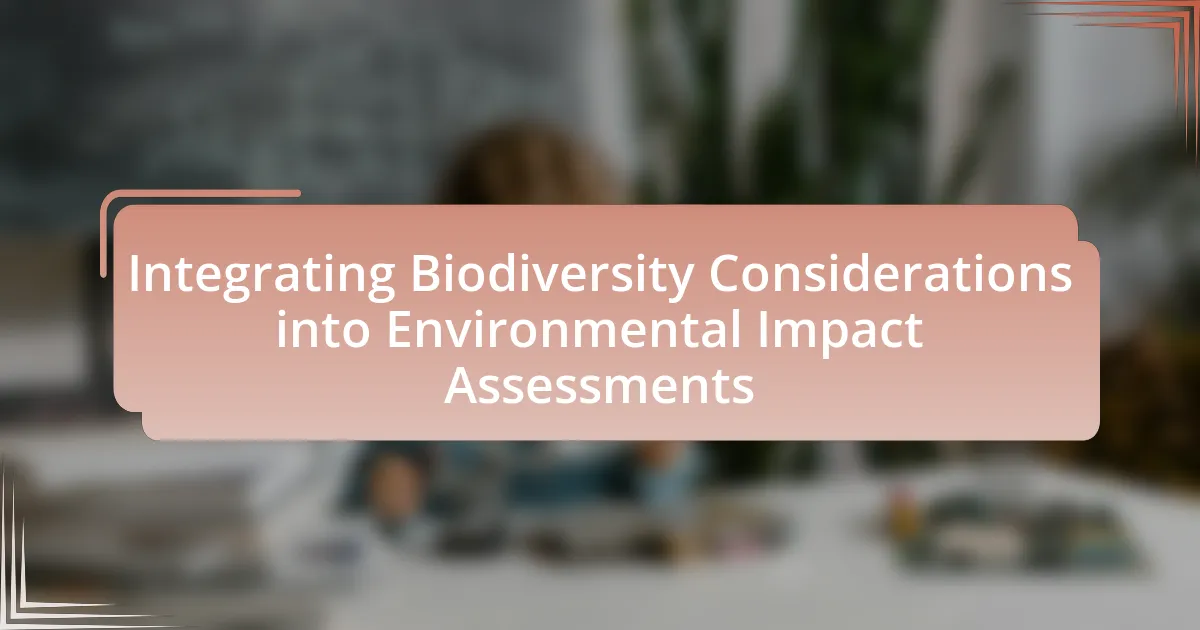The article focuses on integrating biodiversity considerations into Environmental Impact Assessments (EIAs), emphasizing the evaluation of potential impacts on ecosystems, species, and genetic diversity. It outlines the importance of biodiversity in maintaining ecosystem health and providing essential services that support human well-being. Key components of biodiversity, including genetic, species, and ecosystem diversity, are discussed, along with methodologies for effective integration into EIAs. The article also addresses challenges such as data limitations and stakeholder engagement, while highlighting best practices for enhancing project sustainability and long-term ecological resilience through proactive planning and continuous monitoring.

What are Biodiversity Considerations in Environmental Impact Assessments?
Biodiversity considerations in Environmental Impact Assessments (EIAs) involve evaluating the potential effects of proposed projects on ecosystems, species, and genetic diversity. These assessments aim to identify, predict, and mitigate adverse impacts on biodiversity, ensuring that development projects do not lead to significant loss of habitats or species. For instance, the Convention on Biological Diversity emphasizes the importance of integrating biodiversity into decision-making processes, highlighting that over 1 million species are currently threatened with extinction due to human activities. By incorporating biodiversity considerations, EIAs can promote sustainable development and conservation efforts, ultimately contributing to the protection of ecological integrity and resilience.
Why is biodiversity important in environmental assessments?
Biodiversity is crucial in environmental assessments because it provides essential ecosystem services that support human well-being and ecological balance. High biodiversity enhances resilience against environmental changes, ensuring ecosystems can adapt and maintain functionality. For instance, diverse ecosystems can better withstand disturbances such as climate change, disease, and invasive species, which is supported by studies showing that ecosystems with greater species diversity exhibit higher stability and productivity. Furthermore, biodiversity contributes to the regulation of air and water quality, pollination of crops, and nutrient cycling, all of which are vital for sustainable development and resource management.
What role does biodiversity play in ecosystem health?
Biodiversity is crucial for ecosystem health as it enhances resilience, stability, and productivity. Diverse ecosystems can better withstand environmental stressors, such as climate change and disease, due to the variety of species fulfilling different ecological roles. For instance, a study published in the journal “Nature” found that ecosystems with higher species diversity are more productive and can recover more quickly from disturbances. This relationship underscores the importance of maintaining biodiversity to ensure the long-term sustainability and functionality of ecosystems.
How does biodiversity contribute to human well-being?
Biodiversity contributes to human well-being by providing essential ecosystem services that support health, food security, and economic stability. These services include pollination of crops, purification of air and water, and regulation of climate, which are vital for sustaining human life. For instance, a study by the United Nations Environment Programme highlights that ecosystems with high biodiversity are more resilient and can better withstand environmental changes, thus ensuring the availability of resources necessary for human survival. Additionally, diverse biological systems enhance genetic diversity, which is crucial for food production and agricultural resilience, as evidenced by the Food and Agriculture Organization’s reports on the importance of crop diversity in maintaining food security.
What are the key components of biodiversity?
The key components of biodiversity are genetic diversity, species diversity, and ecosystem diversity. Genetic diversity refers to the variety of genes within a species, which is crucial for adaptability and resilience. Species diversity encompasses the different species within a given area, contributing to ecosystem stability and function. Ecosystem diversity involves the variety of habitats and ecological processes, which support the overall health of the planet. These components are essential for maintaining ecological balance and supporting life on Earth, as highlighted by the Convention on Biological Diversity, which emphasizes the importance of these elements in sustaining ecosystems and human well-being.
What types of species are considered in biodiversity assessments?
Biodiversity assessments consider various types of species, including flora, fauna, and microorganisms. These assessments typically focus on species that are endemic, threatened, or invasive, as well as those that play critical roles in ecosystem functions, such as keystone species. For instance, the International Union for Conservation of Nature (IUCN) Red List categorizes species based on their conservation status, providing a framework for identifying species of concern in biodiversity assessments. This categorization helps prioritize conservation efforts and informs environmental impact assessments by highlighting species that may be affected by proposed projects.
How do habitat types influence biodiversity evaluations?
Habitat types significantly influence biodiversity evaluations by determining the variety and abundance of species present in a given area. Different habitats, such as forests, wetlands, and grasslands, support distinct communities of organisms adapted to specific environmental conditions. For instance, a study published in “Ecological Applications” by Díaz et al. (2013) highlights that diverse habitat types contribute to higher species richness and ecosystem resilience, which are critical factors in biodiversity assessments. Consequently, evaluations that consider the specific characteristics of various habitats yield more accurate representations of biodiversity, guiding effective conservation and management strategies.

How can biodiversity considerations be integrated into Environmental Impact Assessments?
Biodiversity considerations can be integrated into Environmental Impact Assessments (EIAs) by systematically evaluating the potential impacts of proposed projects on local ecosystems and species. This integration involves conducting baseline studies to assess existing biodiversity, identifying key species and habitats that may be affected, and employing mitigation strategies to minimize adverse effects. For instance, the International Finance Corporation’s Performance Standards emphasize the need for biodiversity assessments in project planning, which can guide decision-making and ensure compliance with environmental regulations. Additionally, utilizing tools like the Biodiversity Impact Assessment Framework can help quantify impacts and inform conservation measures, thereby reinforcing the importance of biodiversity in sustainable development practices.
What methodologies are used for integrating biodiversity into assessments?
Methodologies for integrating biodiversity into assessments include the use of biodiversity indicators, ecosystem service valuation, and habitat modeling. Biodiversity indicators provide measurable data that reflect the health of ecosystems, allowing for the assessment of species richness and abundance. Ecosystem service valuation quantifies the benefits that biodiversity provides to humans, such as clean water and pollination, facilitating informed decision-making. Habitat modeling employs spatial analysis to predict the distribution of species and habitats, helping to identify critical areas for conservation. These methodologies are supported by frameworks like the Convention on Biological Diversity, which emphasizes the importance of biodiversity in environmental assessments.
How do qualitative and quantitative methods differ in assessing biodiversity?
Qualitative and quantitative methods differ in assessing biodiversity primarily in their approach and data type. Qualitative methods focus on descriptive data, capturing the richness and complexity of ecosystems through observations, interviews, and case studies, which provide insights into species interactions and habitat conditions. In contrast, quantitative methods rely on numerical data, employing statistical analyses to measure biodiversity metrics such as species richness, abundance, and distribution, allowing for objective comparisons and generalizations across different ecosystems. For example, a study published in “Biodiversity and Conservation” by Magurran (2004) highlights that quantitative assessments can reveal patterns in species diversity that qualitative assessments may overlook, thus demonstrating the complementary roles of both methods in comprehensive biodiversity evaluations.
What tools and frameworks support biodiversity integration?
Tools and frameworks that support biodiversity integration include the Biodiversity Indicators Partnership, the Integrated Biodiversity Assessment Tool (IBAT), and the Convention on Biological Diversity’s Aichi Biodiversity Targets. The Biodiversity Indicators Partnership provides a framework for measuring and reporting on biodiversity, while IBAT offers access to critical biodiversity data for decision-making. The Aichi Biodiversity Targets set global goals for biodiversity conservation, guiding policies and practices. These tools and frameworks are essential for effectively incorporating biodiversity considerations into environmental impact assessments, ensuring that ecological impacts are systematically evaluated and addressed.
What challenges exist in integrating biodiversity considerations?
Integrating biodiversity considerations faces several challenges, including data gaps, conflicting stakeholder interests, and the complexity of ecological systems. Data gaps arise from insufficient baseline information on species and ecosystems, making it difficult to assess impacts accurately. Conflicting stakeholder interests can hinder collaboration, as different groups may prioritize economic development over ecological preservation. Additionally, the complexity of ecological systems complicates the prediction of biodiversity responses to environmental changes, leading to uncertainty in impact assessments. These challenges collectively impede effective integration of biodiversity into environmental impact assessments, as highlighted in various studies on environmental management practices.
How do data limitations affect biodiversity assessments?
Data limitations significantly hinder biodiversity assessments by restricting the availability and quality of information necessary for accurate evaluations. Incomplete datasets can lead to underestimations or misrepresentations of species diversity, distribution, and ecological interactions. For instance, a study published in “Ecological Applications” by Newbold et al. (2015) found that gaps in species occurrence data can result in biased predictions of biodiversity loss, affecting conservation priorities and management strategies. Consequently, the lack of comprehensive data can impair decision-making processes in environmental impact assessments, ultimately jeopardizing effective biodiversity conservation efforts.
What are the common misconceptions about biodiversity in assessments?
Common misconceptions about biodiversity in assessments include the belief that biodiversity can be fully captured through species counts alone, and that all species have equal ecological value. Biodiversity assessments often overlook the importance of ecosystem functions and services, leading to an incomplete understanding of ecological health. Additionally, there is a misconception that biodiversity is static, ignoring the dynamic nature of ecosystems and species interactions. Research indicates that effective biodiversity assessments must consider habitat quality, ecological connectivity, and the role of keystone species to provide a more accurate representation of biodiversity’s role in environmental impact assessments.

What are the benefits of integrating biodiversity considerations into Environmental Impact Assessments?
Integrating biodiversity considerations into Environmental Impact Assessments (EIAs) enhances ecological protection and promotes sustainable development. This integration helps identify potential impacts on ecosystems, species, and habitats, allowing for informed decision-making that minimizes harm. For instance, studies have shown that projects incorporating biodiversity assessments can lead to better conservation outcomes, such as the preservation of endangered species and the maintenance of ecosystem services. Furthermore, integrating biodiversity into EIAs can improve stakeholder engagement and public support, as communities often value local biodiversity and its benefits. This approach ultimately leads to more resilient ecosystems and sustainable resource management, aligning with global biodiversity targets and commitments.
How does biodiversity integration enhance project sustainability?
Biodiversity integration enhances project sustainability by promoting ecosystem resilience and functionality. When projects incorporate diverse biological elements, they support a wider range of species and ecological processes, which leads to improved environmental health and stability. Research indicates that ecosystems with higher biodiversity are better equipped to withstand disturbances, such as climate change and pollution, thereby ensuring long-term project viability. For instance, a study published in the journal “Nature” found that diverse ecosystems can recover more quickly from environmental stressors, demonstrating the critical role of biodiversity in sustaining project outcomes.
What long-term benefits can arise from considering biodiversity?
Considering biodiversity leads to long-term benefits such as enhanced ecosystem resilience, improved human health, and sustainable economic growth. Ecosystem resilience is strengthened as diverse biological systems can better withstand environmental changes and disturbances, which is crucial for maintaining ecosystem services. For instance, a study published in the journal “Nature” found that ecosystems with higher biodiversity are more productive and stable over time, supporting the argument that biodiversity contributes to long-term ecological balance.
Additionally, preserving biodiversity can lead to improved human health by ensuring the availability of medicinal resources and promoting clean air and water. The World Health Organization has reported that biodiversity loss can negatively impact health outcomes, emphasizing the importance of diverse ecosystems in disease regulation and prevention.
Finally, integrating biodiversity considerations into environmental impact assessments can foster sustainable economic growth by supporting industries such as agriculture, tourism, and fisheries. The United Nations Environment Programme highlights that biodiversity-rich areas often attract tourism, generating revenue while promoting conservation efforts. Thus, considering biodiversity yields significant long-term benefits across ecological, health, and economic dimensions.
How can stakeholder engagement improve biodiversity outcomes?
Stakeholder engagement can improve biodiversity outcomes by fostering collaboration and incorporating diverse perspectives in decision-making processes. Engaging stakeholders, such as local communities, conservation groups, and industry representatives, ensures that various knowledge systems and values are considered, leading to more effective conservation strategies. Research indicates that projects with active stakeholder involvement are more likely to achieve positive biodiversity results, as seen in the case of the Collaborative Forest Management initiative in Nepal, which resulted in increased forest cover and biodiversity due to local participation and stewardship.
What best practices should be followed for effective integration?
Effective integration of biodiversity considerations into environmental impact assessments requires a systematic approach that includes stakeholder engagement, comprehensive data collection, and adaptive management practices. Stakeholder engagement ensures that local communities and experts contribute valuable insights, enhancing the relevance and accuracy of assessments. Comprehensive data collection involves gathering baseline biodiversity data and understanding ecosystem services, which is crucial for identifying potential impacts. Adaptive management practices allow for ongoing monitoring and adjustments based on new information or changing conditions, ensuring that biodiversity considerations remain relevant throughout the project lifecycle. These practices are supported by guidelines from organizations such as the International Finance Corporation, which emphasizes the importance of integrating biodiversity into project planning and decision-making processes.
How can early planning improve biodiversity assessment outcomes?
Early planning enhances biodiversity assessment outcomes by allowing for the identification and mitigation of potential impacts on ecosystems before project implementation. This proactive approach facilitates the integration of biodiversity considerations into the Environmental Impact Assessment (EIA) process, ensuring that critical habitats and species are protected. Research indicates that projects with early biodiversity planning experience a 30% reduction in negative ecological impacts, as stakeholders can collaboratively develop strategies that prioritize conservation and sustainable practices. By addressing biodiversity concerns at the outset, projects are more likely to achieve compliance with environmental regulations and foster long-term ecological resilience.
What role does continuous monitoring play in biodiversity integration?
Continuous monitoring is essential for effective biodiversity integration as it provides real-time data on ecosystem health and species populations. This ongoing assessment allows for timely adjustments in conservation strategies and environmental management practices, ensuring that biodiversity considerations are consistently addressed throughout project lifecycles. Research indicates that projects with robust monitoring frameworks can adapt to ecological changes, thereby enhancing the resilience of biodiversity in the face of environmental impacts. For instance, a study published in “Biodiversity and Conservation” highlights that continuous monitoring significantly improves the detection of biodiversity loss, enabling proactive measures to mitigate adverse effects.
What practical steps can organizations take to integrate biodiversity considerations?
Organizations can integrate biodiversity considerations by conducting comprehensive biodiversity assessments during the planning phase of projects. This involves identifying and evaluating the potential impacts of proposed activities on local ecosystems and species. For instance, organizations can utilize tools such as the Biodiversity Impact Assessment Framework, which helps quantify biodiversity loss and identify mitigation strategies. Additionally, organizations should engage stakeholders, including local communities and conservation experts, to gather insights and foster collaboration. Implementing biodiversity management plans that outline specific actions, such as habitat restoration and species protection measures, further supports integration. Research indicates that organizations adopting these practices can enhance ecological resilience and comply with regulatory requirements, ultimately leading to more sustainable project outcomes.


